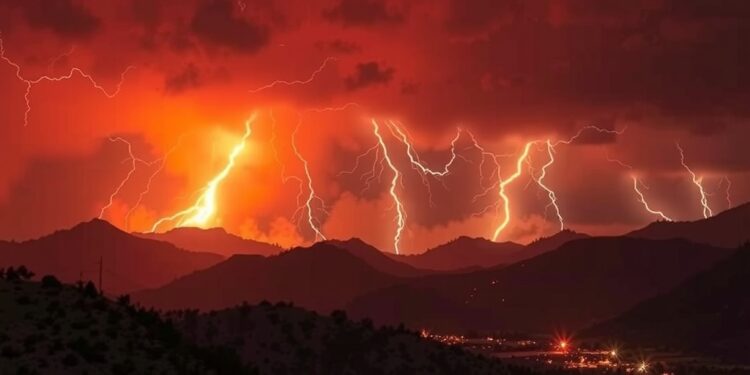A revolutionary leap in our ability to predict wildfires has emerged from a collaborative effort of esteemed researchers in Israel, who have developed a pioneering artificial intelligence (AI) model designed specifically to forecast lightning-induced wildfires. This advanced model comes at a crucial time when climate change has led to an alarming increase in the frequency and intensity of such blazes, posing an ever-growing threat to ecosystems and human communities alike.
This state-of-the-art AI model boasts a remarkable accuracy rate of over 90%, which represents a groundbreaking advancement in the realm of wildfire forecasting. Traditionally, firefighting strategies have relied on less precise methods and regional models that often struggle with the unpredictable nature of lightning-induced fires. By leveraging high-resolution satellite data coupled with an array of environmental variables—including vegetation density, climatic conditions, and topographical features—this new AI model forges a path toward more effective wildfire risk assessments.
The team behind this impressive innovation is led by Dr. Oren Glickman and Dr. Assaf Shmuel from the Department of Computer Science at Bar-Ilan University, who joined forces with researchers from Ariel and Tel Aviv Universities. Their research endeavors involved analyzing seven years of global satellite data, which provided the rich, multifaceted dataset required to train their AI model. The result is a tool that can accurately predict the likelihood of lightning strikes igniting wildfires anywhere in the world, thereby addressing one of the key challenges in wildfire research: the unpredictability of these events.
Wildfires ignited by lightning strikes are particularly insidious, as they can smolder undetected for long periods, often in remote locations, only to erupt into uncontrollable infernos. This behavior complicates early response efforts, significantly hampering firefighting resources’ ability to act in time. The notorious wildfires that wreaked havoc in Northern California in August 2020, ignited by lightning, serve as a stark reminder of the devastating consequences posed by these natural events. With the new AI model’s precision, it is hoped that emergency services can implement proactive measures that result in lives saved and ecosystems preserved.
As extreme weather events become more common due to climate change—characterized by increased lightning storms, prolonged dry spells, and shifts in ecosystems—the relevance of such a predictive model becomes even more pronounced. Current wildfire prediction models primarily focus on human-induced blazes, largely ignoring the complexities associated with lightning-initiated fires that typically evolve in challenging terrains. This innovative approach by Dr. Glickman and his team aims to fill that knowledge gap by providing a comprehensive understanding of how lightning strikes influence wildfire patterns across various landscapes.
The researchers’ methodology represents a shift away from conventional fire danger indices, which often provide limited insights based solely on historical data without the benefit of real-time updates from satellite technology. This AI-driven model seamlessly integrates satellite data with weather patterns and ecological configurations, allowing it to assess lightning fire risks more dynamically and accurately than existing methods. Its development is a testament to the potential that machine learning holds in guiding fire management policies and practices globally.
As the team prepares their model for deeper integration into real-time forecasting systems, the broader implications for its deployment in disaster management and emergency response strategies cannot be overstated. For example, a more robust predictive capacity could enable meteorological agencies to announce warnings well in advance, allowing communities at risk to prepare and respond appropriately. It can bolster firefighting efforts by optimizing resource allocation based on predicted fire risks, transforming reactive measures into proactive ones aimed at fire prevention.
The research has been meticulously documented and was recently published in a prestigious academic journal, underscoring the rigor and significance of the findings. The publication serves not only as a validation of the research methodology but also as a call to action for the development of further applications of machine learning in predicting natural disasters influenced by climate phenomena. This breakthrough underscores the pressing need for more innovative solutions as we grapple with the reality of a changing climate.
Addressing the complexity and unpredictability of lightning-induced wildfires is essential for fire mitigation efforts. This new model could revamp fire response strategies, enhancing the capability of firefighters and emergency responders to act quickly and decisively when faced with sudden outbreaks. As Dr. Shmuel appropriately points out, the need for advanced modeling tools is a direct response to the urgent challenges posed by climate change.
The volatility of wildfire incidents can have dire consequences not only on human life but also on environmental health. Several ecosystems face irreversible damage due to the increasing frequency and severity of these fires, primarily driven by climate-related factors. Thus, harnessing such an advanced AI solution could be vital for coordinating conservation efforts and maintaining biodiversity in a rapidly changing environment.
In closing, the advent of this innovative AI model offers a beacon of hope against wildfire catastrophes exacerbated by climate change. The capacity to accurately forecast the likelihood of lightning-induced wildfires elevates our readiness and adaptability, creating new pathways for disaster response and resource management that can translate into lives saved and ecosystems preserved. It is a striking reminder of how cutting-edge technology can link seamlessly with nature’s complexity to tackle one of the most pressing environmental challenges of our time.
Subject of Research: Wildfire prediction using artificial intelligence
Article Title: Global lightning-ignited wildfires prediction and climate change projections based on explainable machine learning models
News Publication Date: 6-Mar-2025
Web References: Scientific Reports
References: None
Image Credits: None
Keywords
Wildfires, Lightning, Machine Learning, Artificial Intelligence, Climate Change, Natural Disasters, Environmental Science, Disaster Management




